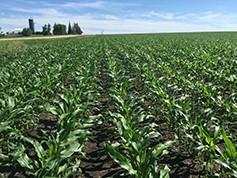Corn planting dates varied this spring depending on soil moisture and temperature, both of which are critical for proper germination. Information from Iowa State University’s extension and outreach office indicates corn planting in Iowa during a typical year can take place any time from early April to mid-May, depending on the location.
For Iowa farmer Greg Alber, planting conditions in April were suitable and allowed him to get his crop in the ground on time. By mid-June the corn in his fields had reached the vegetative growth stage with plants having six fully expanded corn leaves, often referred to as V6 stage.
“The corn is really looking good,� he said. “We were able to get into the field on time, and weather conditions were favorable for the early part of the growing season.�
In fact, much of the U.S. Corn Belt is also seeing the makings of a successful corn crop. The U.S. Department of Agriculture’s (USDA) national crop progress report for the end of June, which includes 18 of the top corn-producing states, shows the crop is rated at 54 percent good and 14 percent excellent. These figures are consistent with estimates from the previous year at the same time.
Much of the corn-growing region received above normal rainfall in early June, and that was followed by warm drying days making the wet conditions manageable for most U.S. corn farmers. Natural drainage and slope of the fields were also effective to manage the amount of rainfall.
“Additional rainfall events have produced some excessively wet conditions and standing water in some parts, especially in areas on the river side of levees,â€� said Paul Bertels, vice president of production and sustainability at National Corn Growers Association.
“The majority of corn in the Midwest was deep enough into the soil and had taken in enough nitrogen to avoid detrimental stress when a tropical depression passed through the U.S. Corn Belt in mid-June,� Bertels said. “But since that time we’ve had additional heavy rainfall causing damage to some of the crop, and we’re seeing that reflected in USDA estimates.�
The end of June report has estimates of 88.897 million acres (35.9 million hectares) planted, approximately 300,000 acres (121,000 hectares) less than the March estimate of 89.199 million acres (36 million hectares) and 2 percent lower than last year’s total of 90.597 million acres (37 million hectares).
Throughout the remainder of the growing season, Alber will monitor his fields closely using an aerial drone, which allows him to analyze imagery from the fields and determine any areas that require attention. He uses other technology services, including smartphone applications, to monitor soil moisture and temperature, nitrogen levels and overall field health. The information gathered is delivered via text message and compliments the data collected by the drone.
Alber is pleased with the start of this year’s corn crop and is hopeful that weather conditions will remain favorable throughout the growing season. “This year’s crop is shaping up to be better than 2014,� he said.


